Scottish greenhouse gas emissions 2016
This publication provides estimates of greenhouse gas emissions in Scotland for the years 1990 to 2016.
Section B: Results – Net Sources of Scottish Greenhouse Gas Emissions
2016 figures
Chart B1 presents the sources and sinks of Scottish Greenhouse Gas Emissions in 2016, grouped by Scottish Government sector.
Chart B1: Sources of Scottish Greenhouse Gas Emissions, 2016. Values in MtCO2e
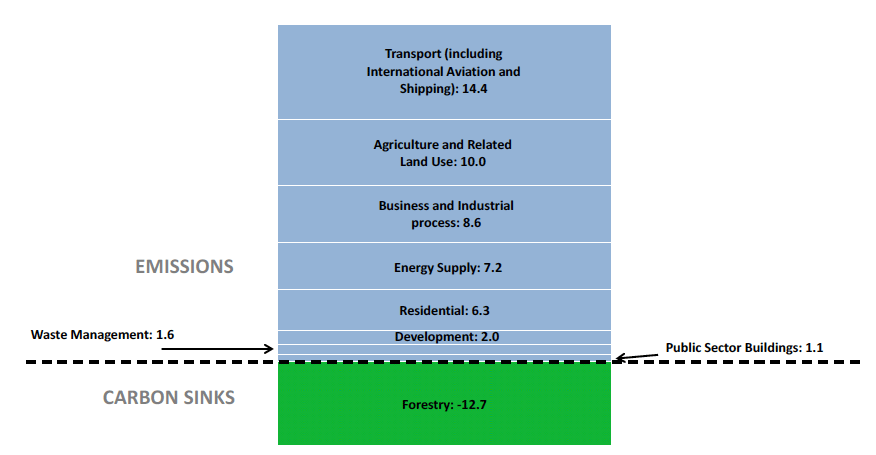
Main points
- In 2016, Transport (including International Aviation and Shipping) (14.4 MtCO2e) was the largest source of net emissions followed by Agriculture and Related Land Use (10.0 MtCO2e) and Business and Industrial Process (8.6 MtCO2e).
- Forestry was the only aggregate sector in which there has been a net emissions sink (-12.7 MtCO2e).
Table B1. Scottish Greenhouse Gas Emissions by Gas and by Scottish Government Source Sector, 2016. Values in MtCO2e
|
|
Total |
Percentage share by sector |
Carbon dioxide |
Methane |
Nitrous oxide |
Fluorinated gases |
|---|---|---|---|---|---|---|
| Total |
38.6 |
100.0% |
27.2 |
6.5 |
3.4 |
1.4 |
| Transport (including International Aviation and Shipping) |
14.4 |
37.3% |
14.2 |
0.0 |
0.2 |
0.0 |
| Transport (excluding IA&S) |
12.6 |
32.6% |
12.4 |
0.0 |
0.1 |
0.0 |
| International Aviation and Shipping (IA&S) |
1.8 |
4.7% |
1.8 |
0.0 |
0.0 |
0.0 |
| Energy Supply |
7.2 |
18.6% |
6.7 |
0.4 |
0.1 |
0.0 |
| Agriculture and related land use |
10.0 |
26.1% |
2.9 |
4.4 |
2.7 |
0.0 |
| Business and Industrial process |
8.6 |
22.2% |
7.2 |
0.0 |
0.1 |
1.3 |
| Residential |
6.3 |
16.4% |
6.1 |
0.1 |
0.0 |
0.1 |
| Development |
2.0 |
5.2% |
1.9 |
0.0 |
0.1 |
0.0 |
| Waste Management |
1.6 |
4.3% |
0.0 |
1.5 |
0.1 |
0.0 |
| Public Sector Buildings |
1.1 |
2.8% |
1.1 |
0.0 |
0.0 |
0.0 |
| Forestry |
-12.7 |
-32.8% |
-12.7 |
0.0 |
0.1 |
0.0 |
Main points
Carbon dioxide was the main greenhouse gas emitted or removed in most sectors, with the exceptions of the Agriculture and Related Land Use and Waste Management sectors.
- Methane was the main net gas emitted in the Agriculture and Related Land Use sector (4.4 MtCO2e), followed by carbon dioxide (2.9 MtCO2e) and nitrous oxide (2.7 MtCO2e).
- Almost all emissions in the Waste Management sector were emitted in the form of methane (1.5 MtCO2e).
Where F gases are emitted, they have been in relatively small amounts via the Business and Industrial Process source sector, as well as in the Residential sector.
Key Trends By Scottish Government Source Sector
Chart B2 presents the main sources of Scottish Greenhouse Gas Emissions in Scotland from 1990 to 2016, broken down by Scottish Government source sector. Note that for the purposes of presentation, some sectors have been grouped together on this chart. Chart B3 and Chart B4 specifically explore the trend in Energy Supply emissions. Chart B5 contains information on the absolute and percentage reductions in greenhouse gas emissions in every Scottish Government source sector over the entire time period, with Chart B6 containing the same information for the latest year.
Chart B2: Main Sources of Greenhouse Gas Emissions in Scotland, 1990 to 2016. Values in MtCO2e
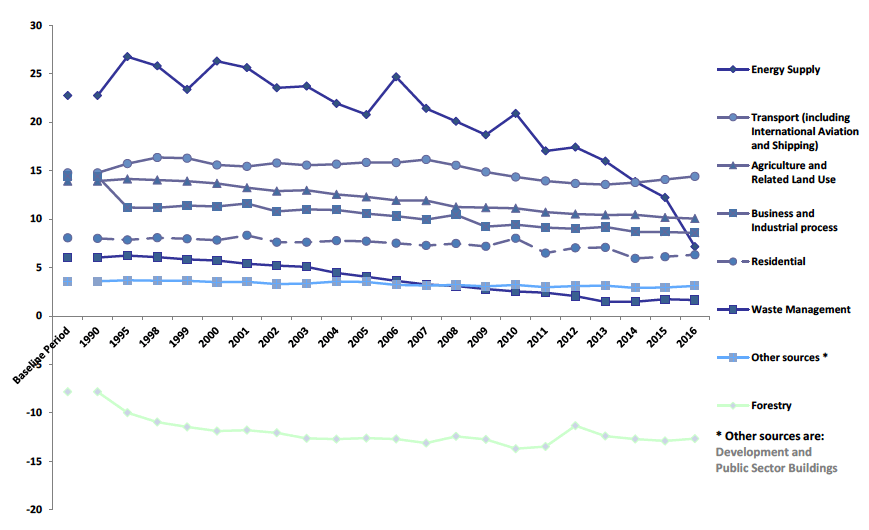
Main Points
Most sectors exhibit a general downwards trend between 1990 and 2016. Between 1990 and 2016:
- Energy Supply emissions have seen the largest decrease in MtCO2e (15.6 MtCO2e, 68.5 per cent) followed by Business and Industrial Process (5.8 MtCO2e, 40.5 per cent) and Waste Management (4.4 MtCO2e, 72.8 per cent).
- International Shipping and Aviation emissions have increased (0.5 MtCO2e, 39.7 per cent) along with Development emissions (0.1 MtCO2e, 7.0 per cent)
- The Forestry sink has increased (4.8 MtCO2e, 61.8 per cent).
Chart B3 shows that the generation of Scotland’s electricity changes over time. Emissions from the electricity supply sector (such as power stations) are associated with these changes.
Chart B3: Generation of Electricity by Fuel, Scotland, 2000 to 2016. Percentage of Electricity Generated by Year
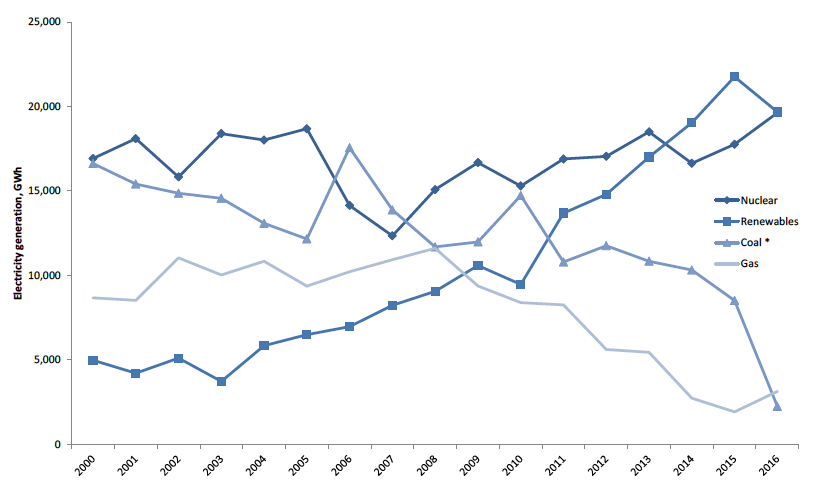
Data obtained from BEIS Energy Trends[5]
Main Points
Renewables were the single largest source of electricity generated in Scotland in 2016 at 42.9 per cent, closely followed by nuclear generation at 42.8 per cent with fossil fuel generation making up only 13.2 per cent. Overall electricity generation in Scotland decreased by 5,506 GWh to 45,845 GWh in 2016. Since 2000, Scotland has seen a decline in coal and gas electricity generation and an increase in generation from renewables.
Chart B4 shows the gas and coal prices for large users in the UK. The use of coal or gas in electricity generation can be sourced to these price effects in many cases. The decline in oil prices between 2013-2016 brought down oil-indexed gas prices, dropping the price of gas around the world. Other potential reasons for lower gas prices include an increase in liquefied natural gas supply and a slowdown in worldwide demand growth.
Chart B4: Gas and Coal Prices for Large Users in the UK (2004 to 2016) – pence per kWh
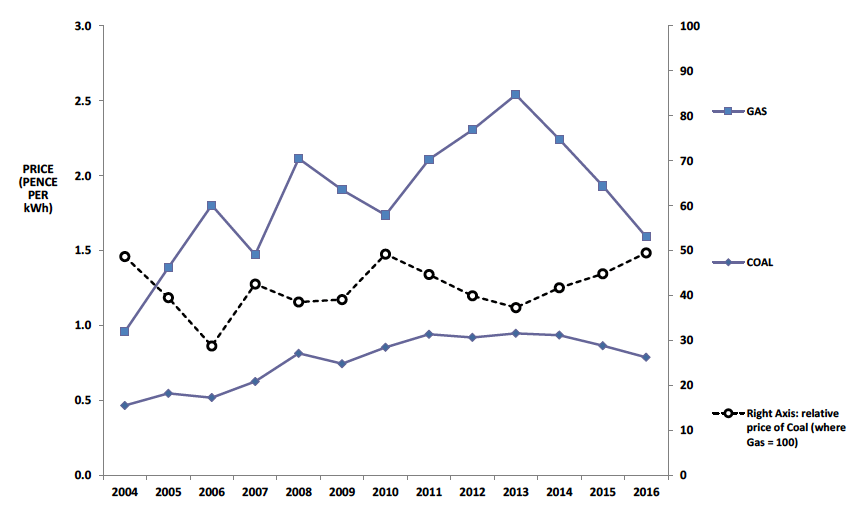
Data obtained from BEIS[6]
Long term (1990 to 2016) and short term (2015 to 2016) trends by sector
Chart B5 shows how emissions have changed between 1990 and 2016 in all source sectors. Chart B6 shows how emissions have changed between 2015 and 2016.
Chart B5: Change in Net Emissions by Scottish Government Sector Between 1990 and 2016 – in MtCO2e, and percentage changes [7]
![Chart B5: Change in Net Emissions by Scottish Government Sector Between 1990 and 2016 – in MtCO2e, and percentage changes [7] Chart B5: Change in Net Emissions by Scottish Government Sector Between 1990 and 2016 – in MtCO2e, and percentage changes [7]](/binaries/content/gallery/publications/statistics/2018/06/scottish-greenhouse-gas-emissions-2016/SCT05187496341_g09.gif)
Chart B6: Change in Net Emissions by Scottish Government Sector between 2015 and 2016 - in MtCO2e, and percentage changes [8]
![Chart B6: Change in Net Emissions by Scottish Government Sector between 2015 and 2016 - in MtCO2e, and percentage changes [8] Chart B6: Change in Net Emissions by Scottish Government Sector between 2015 and 2016 - in MtCO2e, and percentage changes [8]](/binaries/content/gallery/publications/statistics/2018/06/scottish-greenhouse-gas-emissions-2016/SCT05187496341_g10.gif)
Total Emissions
Overall, there has been a 37.0 MtCO2e (49.0 per cent) decrease in net emissions between 1990 and 2016, and there has been a 4.4 MtCO2e (10.3 per cent) decrease in net emissions between 2015 and 2016.
Energy Supply (19 per cent of 2016 inventory)
Energy sector emissions have decreased by 41.4 per cent from 2015-2016 from 12.2 MtCO2e to 7.2 MtCO2e, and have reduced by 68.5 per cent from 1990. Emissions reductions in this sector are mainly due to reductions in emissions from power stations.
Power station emissions have reduced by 83 per cent due primarily to the shift in fuel mix away from coal to use less carbon intensive fuels for generation, including increased use of nuclear and renewables, with even the use of natural gas now reducing in Scotland. This sector alone accounts for 33 per cent of the decline in Scotland emissions since the base year.
Residential (16 per cent of 2016 inventory)
Residential emissions have increased between 2015 and 2016 from 6.1 MtCO2e to 6.3 MtCO2e (3.3 per cent). However, there has been a decrease of 21.1 per cent from 1990-2016. This long-term decrease is mainly due to a switch from less efficient solid and liquid fuels to natural gas for heating, and improvements in energy efficiency.
The main driver for the increase in residential emissions from 2015 to 2016 is an increase in the combustion of fuel in households, dominated by an increase in natural gas use, possibly reflecting cooler mean temperatures in winter and autumn months in 2016 compared to 2015 (Chart B7).
Chart B7: Mean air temperature by month, Scotland. 2015 and 2016. Values in °C
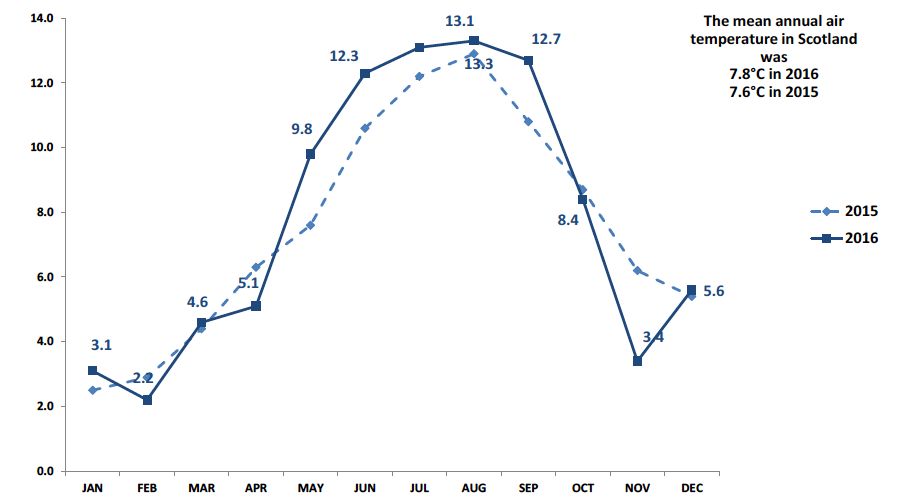
Data obtained from Met Office[9]
Waste Management (4 per cent of 2016 inventory)
From 2015 to 2016 waste management decreased from 1.7 MtCO2e to 1.6 MtCO2e, a 4.9 per cent reduction. From 1990 to 2016 emissions have reduced by 72.8 per cent. This decrease is largely due to the progressive introduction of methane capture and oxidation systems within landfill management.
Business and Industrial Process (22 per cent of 2016 inventory)
This sector has seen a 5.8 MtCO2e (40.5 per cent) fall in emissions between 1990 and 2016. As shown in Chart B2, much of this decrease occurred between 1990 and 1995 – linked to a decline in emissions from manufacturing and the iron and steel industry over this time period. There has been a further smaller decrease between 2008 and 2009, coinciding with the recession. There was a decrease (0.1 MtCO2e; 1.1 per cent) in emissions in this sector between 2015 and 2016. This has been driven by a number of factors, which include a reduction in emissions from manufacturing.
Combustion of fossil fuels in industrial production remains a major emission source in Scotland but shows a strong decline of approximately 59 per cent since 1990. This is due to plant closures, fuel-switching to less carbon intensive fuels and improvements in efficiency of production.
Agriculture and Related Land Use (26 per cent of 2016 inventory)
This sector has seen a 3.9 MtCO2e (27.8 per cent) fall in net emissions between 1990 and 2016. Between 2015 and 2016, there was a 0.1 MtCO2e (1.1 per cent) decrease in net emissions of overall greenhouse gases from this sector.
This decrease is mainly due to a decrease in livestock numbers (particularly cattle and sheep).
Forestry (33 per cent of the 2016 inventory)
From 2015 to 2016, the forestry sink has decreased by 1.8 per cent from -12.9 MtCO2e to -12.7 MtCO2e. This is mainly due to a decrease in forest land remaining forest land.
Scotland was a net sink of greenhouse gases from Forestry activities from 1990-2016.
The main influences on the trend for the Forestry sector in Scotland is the increasing sink of forest land remaining forest land (a sink of 69 per cent greater magnitude since 1990).
Transport Including International Aviation and Shipping (37 per cent of 2016 inventory)
Transport emissions have increased by 2.3 per cent from 2015 to 2016. Transport emissions decreased by 2.5 per cent from 1990 to 2016. The increase in emissions in 2016 was mainly due to an increase in emissions from road transport, in particular passenger cars and light duty trucks.
In 2016, road transport was the largest source of emissions in Scotland. Road transport emissions have increased by 7 per cent between the 1990 and 2016; this is due to a growth in activity over the period offset partly by improvements in the efficiency of vehicles.
International Aviation (4 per cent of 2016 inventory)
International aviation has increased from 1.3 MtCO2e in 2015 to 1.4 MtCO2e in 2016. An increase of 8.0 per cent from 2015 to 2016. Emissions from international aviation from Scotland have increased by 165 per cent since 1990 because of greater demand.
International Shipping (1 per cent of 2016 inventory)
Emissions from international shipping increased slightly by 3.6 per cent from 2015 to 2016. Emissions from international shipping have declined since 1990 by 49 per cent.
Public Sector Buildings (3 per cent of the 2016 inventory)
The main source of emissions from this sector is the use of natural gas for heating public buildings. There was a 0.6 MtCO2e (36 per cent) fall in emissions from public sector buildings between 1990 and 2016. This has been largely driven by a reduction in the use of oil and coal for space heating. Between 2015 and 2016, there has been a 1.9 per cent increase in emissions from this sector.
Development Emissions (5 per cent of 2016 inventory)
This sector captures net emissions from settlements and from land converted to settlements. In 2009 there was a step change increase in development emissions (e.g. emissions from conversion of land to settlements). The longer term trend from 1990 to 2016 shows a 7 per cent increase.
The increase in emissions in the “Land Converted to Settlement” category in 2009 arises from the “Forest Land to Settlement” subcategory. For the 1990 to 2016 inventory the annual deforestation area dataset was updated using spatial data from the National Forest Inventory. In Scotland, the new dataset estimates that the rates of deforestation for Settlement purposes from 2009 to 2011 were considerably higher than the previous 3 years (2006 to 2008).
Emissions by type of gas
Chart B8 shows the trends in emissions, broken down by gas from 1990 to 2016.
Chart B8: Scottish Greenhouse Gas Emissions, by Gas, 1990-2016. Values in MtCO2e
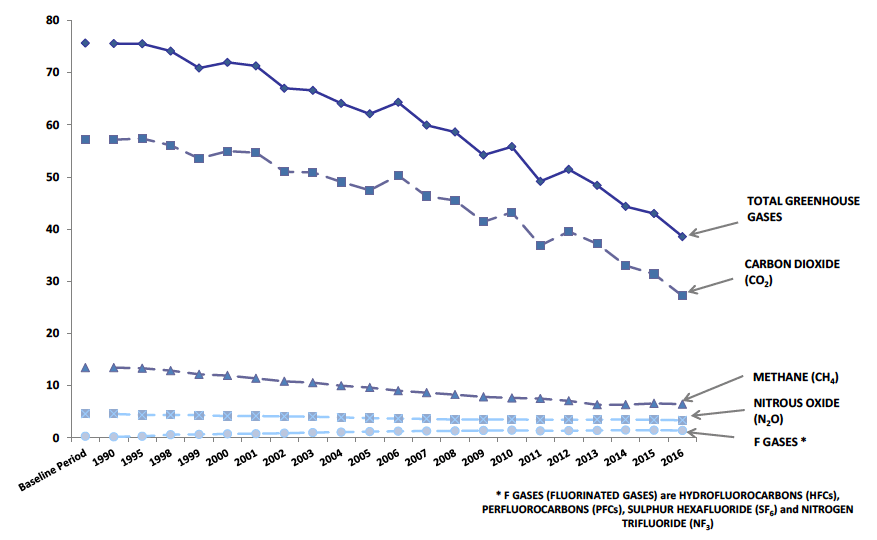
Main Points
- Carbon dioxide is by far the largest contributor to Scottish greenhouse gas emissions in all years (70.5 per cent of all emissions in 2016) and is the most volatile series of all gases – largely driven by changes in energy supply emissions and to a lesser extent, emissions from the residential and business and industrial process sectors.
- Methane is the second most common greenhouse gas in 2016 (16.7 per cent of all net emissions) followed by nitrous oxide (8.8 per cent) and F-gases making up the remainder (3.6 per cent).
- Carbon dioxide has seen the largest percentage reduction from 1990 to 2016 (52.4 per cent). There have also been percentage reductions for both methane (52.1 per cent) and nitrous oxide (26.3 per cent). Emissions from fluorinated gases have shown a large increase from 1990 to 2016 and this increase is driven by the introduction of hydrofluourocarbons (HFCs) from 1995 onwards. These HFCs replace chlorofluorocarbons (CFCs) which were banned by the Montreal Protocol due to their impact on the ozone layer.
Charts B9 to B12 present results on individual gases broken down by main Scottish Government sectors over time. Chart B9 shows how carbon dioxide emissions have changed from 1990 to 2016.
Carbon Dioxide (CO2)
Chart B9: Carbon Dioxide (CO2) Emissions by Scottish Government Sector, 1990 to 2016. Values in MtCO2e
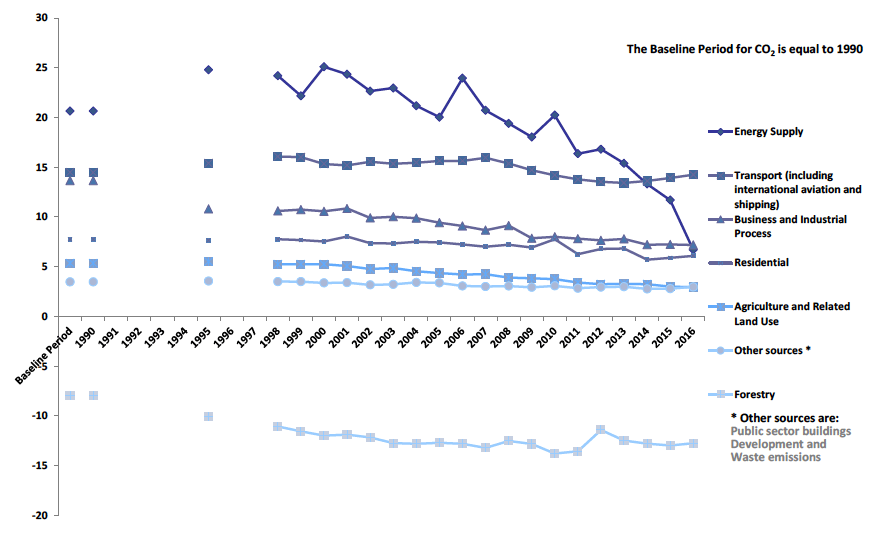
Main Points
- Chart B9 shows that energy supply is a key source of carbon dioxide emissions in all years between 1990 and 2016. Transport (including international aviation and shipping) is the next most common source of carbon dioxide emissions. Transport is 7.5 MtCO2e higher than energy supply emissions in 2016. In 2014 Transport became the highest source of emissions for the first time in the time series.
- Much of the decrease in carbon dioxide emissions between 1990 and 2016 has been driven by falls in the energy supply sector across the time period and in business and industrial processes between 1990 and 1995. Carbon dioxide emissions from the energy supply sector have been volatile, with the highest emissions occurring between 1995 and 2003, and a spike in 2006, related to a greater use of coal in that year.
- The agriculture and related land use sector has also seen a fall in net emissions of carbon dioxide – largely due to changes in land uses.
- Forestry has been a net sink of carbon dioxide consistently between 1990 and 2016.
Methane (CH4)
Chart B10: Methane (CH4) Emissions by Scottish Government Sector, 1990 to 2016. Values in MtCO2e
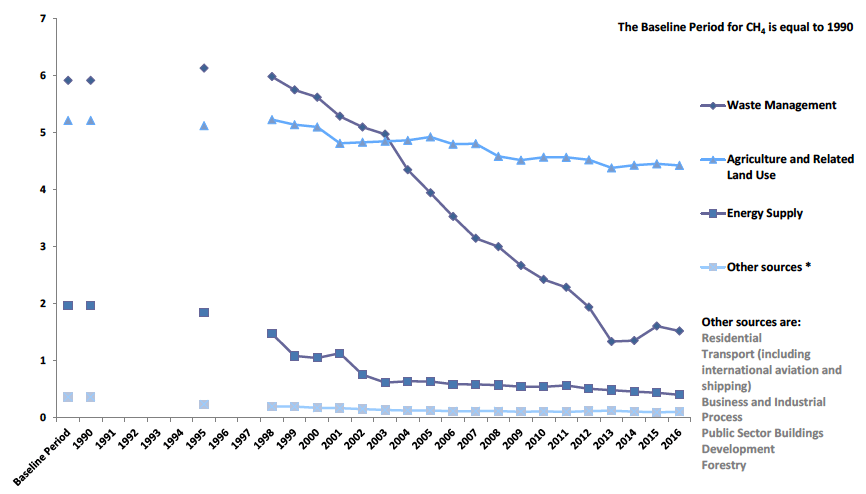
Main Points
- Methane emissions from waste management have fallen from 5.9 MtCO2e in 1990 to 1.5 MtCO2e in 2016 (a 74.0 per cent reduction). This is due to the progressive introduction of landfill gas being captured and used for energy. There could also be other factors which contribute to this reduction, such as improvements in the standards of landfill and changes to the types of waste going to landfill.
- Methane emissions in the agriculture and related land use sector have fallen from 5.2 MtCO2e in 1990 to 4.4 MtCO2e in 2016 – a 15.0 per cent fall over this time period. This reduction is partly linked to a fall in livestock numbers.
- In the Energy Supply sector, methane emissions have fallen from 2.0 MtCO2e in 1990 to 0.4 MtCO2e in 2016, largely due to reductions in emissions from sources such as coal mining.
Nitrous Oxide (N2O)
Chart B11: Nitrous Oxide (N2O) Emissions by Scottish Government Sector, 1990 to 2016. Values in MtCO2e
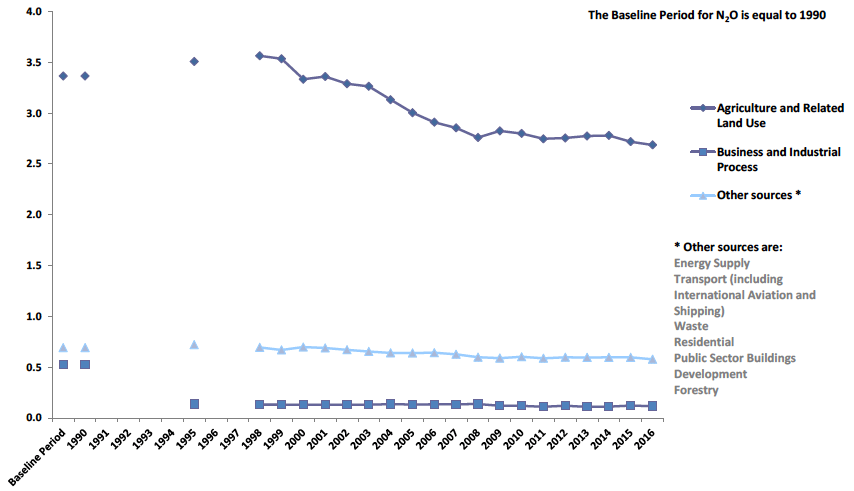
Main Points
- The Agriculture and related land use sector is by far the main contributor to emissions of nitrous oxide. These are largely produced by agricultural practices on soils, and to a lesser extent by animal manures. Emissions of nitrous oxide in this sector have fallen from 3.4 MtCO2e in 1990 to 2.7 MtCO2e in 2016.
- Emissions of nitrous oxide in the business and industrial process sector have fallen from 0.5 MtCO2e in 1990 to 0.1 MtCO2e in 2016.
Fluorinated gases (F-gases)
Chart B12: F-gas Emissions by Scottish Government Sector, 1990 to 2016. Values in MtCO2e
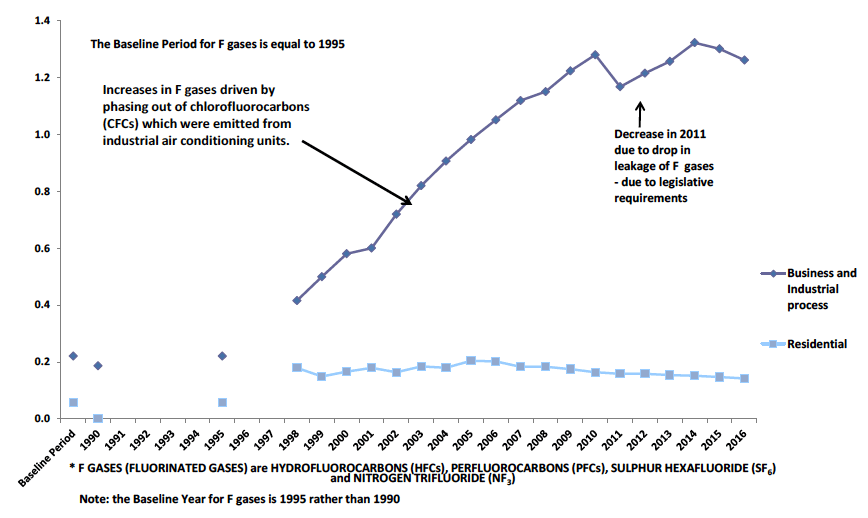
Main Points
- F gases are the most potent greenhouse gases with high global warming potentials but they are emitted in very small quantities. As a result, they contribute less to global warming than the other greenhouse gases in Scotland.
- There has been a sharp increase in F gas emissions from business and industrial processes between 1990 and 2016 (from 0.2 MtCO2e in 1990 to 1.3 MtCO2e in 2016). This is because F gases were introduced to replace chlorofluorocarbons (CFCs), which were used in appliances such as industrial air conditioning units. CFCs were banned under the Montreal Protocol, as they were contributing to the depletion of the ozone layer.
- F gas emissions in the residential sector are caused by the use of aerosols and asthma inhalers, and represent between 0.15 and 0.20 MtCO2e in the years between 1998 and 2016.
Contact
Email: ccstatsmodelling@gov.scot
There is a problem
Thanks for your feedback